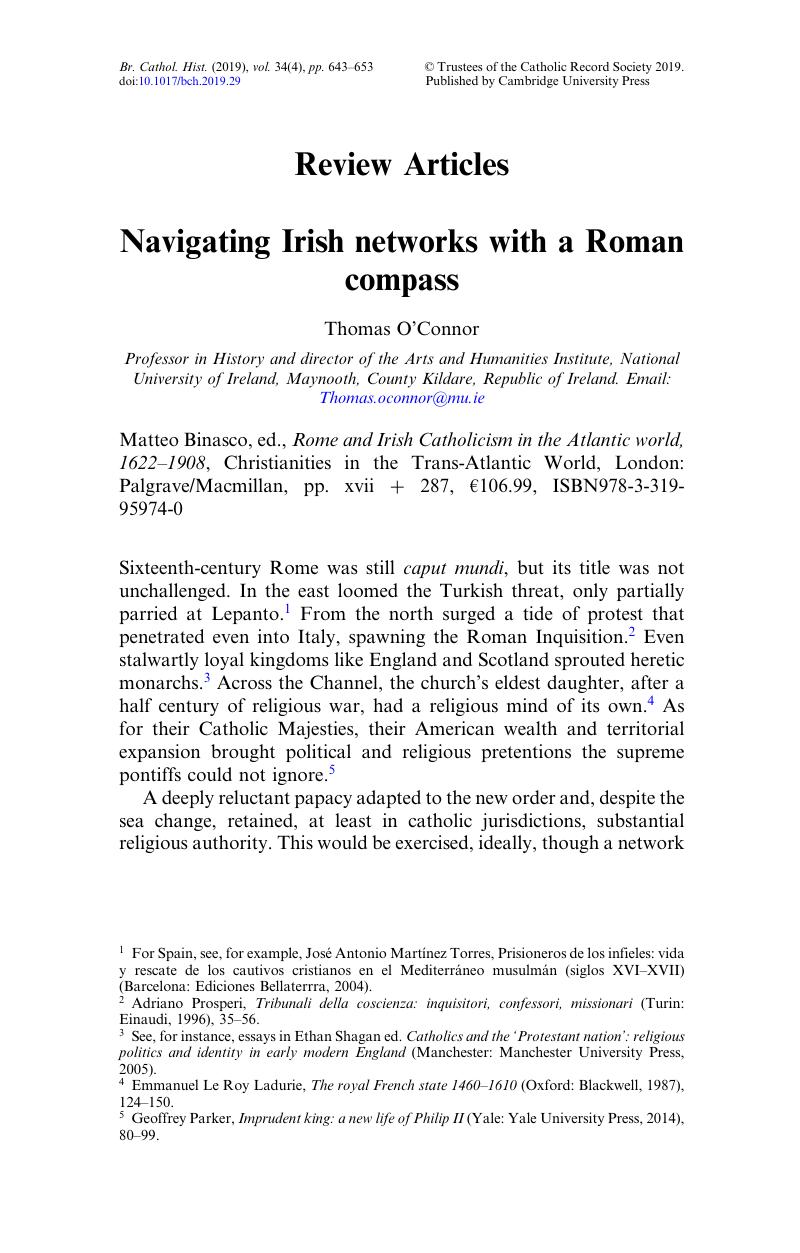No CrossRef data available.
Article contents
Navigating Irish networks with a Roman compass
Review products
Published online by Cambridge University Press: 02 October 2019
Abstract

- Type
- Review Article
- Information
- Copyright
- © Trustees of the Catholic Record Society 2019. Published by Cambridge University Press
References
1 For Spain, see, for example, José Antonio Martínez Torres, Prisioneros de los infieles: vida y rescate de los cautivos cristianos en el Mediterráneo musulmán (siglos XVI–XVII) (Barcelona: Ediciones Bellaterrra, 2004).
2 Prosperi, Adriano, Tribunali della coscienza: inquisitori, confessori, missionari (Turin: Einaudi, 1996), 35–56.Google Scholar
3 See, for instance, essays in Ethan Shagan ed. Catholics and the ‘Protestant nation’: religious politics and identity in early modern England (Manchester: Manchester University Press, 2005).Google Scholar
4 Emmanuel Le Roy Ladurie, The royal French state 1460–1610 (Oxford: Blackwell, 1987), 124–150.Google Scholar
5 Parker, Geoffrey, Imprudent king: a new life of Philip II (Yale: Yale University Press, 2014), 80–99.Google Scholar
6 According to the Calendar of Papal Letters relating to Great Britain and Ireland, between 1447 and 1492 over five hundred dispensations from illegitimacy for clerical sons wishing to enter holy orders were granted, the vast majority relating to Ireland and Scotland. See Heath, Peter, The English parish clergy on the eve of the Reformation, (London: Routledge, 1969), 107.Google Scholar
7 McCoog, Thomas M., , S.J., The Society of Jesus in Ireland, Scotland, and England, 1598–1606: ‘Lest Our Lamp be entirely Extinguished’ (Leiden: Brill, 2017).CrossRefGoogle Scholar
8 See Vera Moynes ed. The Jesuit Irish mission: a calendar of correspondence 1566–1752 (Rome: Institutum Historicum Societatis Iesu, 2017).Google Scholar
9 O’Connor, Thomas, ‘Prequels: the Irish European Diaspora’ in Gisela Holfter and Bettina Migge eds. Ireland in the European Eye (Dublin: Royal Irish Academy, 2019), 3–19.CrossRefGoogle Scholar
10 For an overview, see Blouin, Francis X. Jr. ed. Vatican archives: an inventory and guide to historical documents of the Holy See (Oxford: Oxford University Press, 1998); Sanfilippo, Matteo and Pizzorusso, Giovanni eds. Gli archivi della Santa Sede come fonte per la storia moderna e contemporanea (Viterbo: Sette Città, 2001).Google Scholar
11 Goldstein, Doris S., ‘The origins and the early years of the English Historical Review ’ English Historical Review, 101, 398 (1986): 6–19.CrossRefGoogle Scholar
12 The classic account in English is Owen Chadwick, Catholicism and history: the opening of the Vatican archives (Cambridge: Cambridge University Press, 1978)Google Scholar; Walsh, Katherine, ‘The opening of the Vatican Archives (1880–1881) and Irish historical research’ Archivium Hibernicum 36 (1981): 34–43.CrossRefGoogle Scholar
13 British Library, London, Add. MS 15, 351–15, 400. See Thomas, Francis Sheppard, Notes of materials for the history of public departments (London, 1846), 51.Google Scholar
14 Moran, Patrick Francis ed. Spicilegium Ossoriense: being a collection of original letters and papers illustrative of the history of the Irish Church from the reformation to the year 1800, 3 vols (Dublin: W. B. Kelly, 1874–84).Google Scholar
15 Tussing, Nicholas J., ‘The Politics of Leo XIII’s opening of the Vatican Secret Archives: the ownership of the past’ in The American Archivist 70 (2007): 364–86.CrossRefGoogle Scholar
16 Acta Apostolicae Sedis, 16 [1883–84], (Rome, 1906), 49–57.
17 London, Public Records Office, 1896–1913. This project continues under the auspices of the Irish Manuscripts Commission. See, inter alia, Macquarrie, Alan ed. Calendar of entries in the Papal Registers relating to Great Britain and Ireland. Papal Letters, Volume XXIII, Part I, 1523–1534, Clement VII, Lateran Registers, (Dublin: Irish Manuscripts Commission, 2017).Google Scholar
18 Fenning, Hugh, The Undoing of the Friars of Ireland (Louvain: Publications Universitaires de Louvain, 1972).Google Scholar
19 hAnnracháin’s, Tadhg Ó Catholic Europe 1592-1648: centres and peripheries (Oxford: Oxford University Press, 2015).CrossRefGoogle Scholar
20 Bergin, Joseph, Church, society and religious change in France 1580–1730 (New Haven: Yale University Press, 2009), xv.CrossRefGoogle Scholar
21 O’Connor, Thomas, ‘Irish collegians in Spanish service (1560–1803),’ in Liam Chambers and Thomas O’Connor eds. Forming Catholic Communities: Irish, Scots and English college networks in Europe, 1568–1918 (Leiden: Brill, 2018), 15–38.Google Scholar
22 See Binasco, Matteo and Orschel, Vera, ‘Prosopography of Irish students admitted to the Irish College, Rome, 1628–1798’ in Archivium Hibernicum, 66 (2013): 16–62.Google Scholar
23 Boute, Bruno, Academic interests and catholic confessionalisation: the Louvain privileges of nomination to ecclesiastical benefices (Leiden: Brill, 2010), passim.CrossRefGoogle Scholar
24 For a fuller treatment, see Carroll, Clare Lois, Exiles in a global city: the Irish and early modern Rome, 1609–1783 (Leiden: Brill, 2018), 89–143.CrossRefGoogle Scholar




